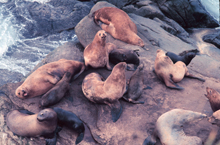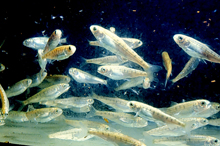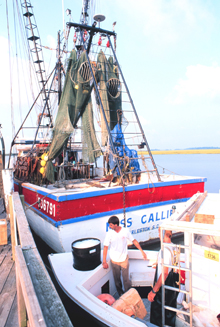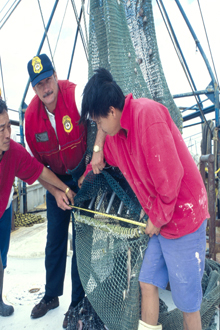Protected Resources—What Does the Future Hold?
NOAA is responsible for the conservation, management, and protection of marine mammals and endangered and threatened species in all waters within the U.S. Exclusive Economic Zone. Recovering mammals and species populations, structures, and functions to the point that they are removed from the endangered species list is a priority for NOAA.
- Introduction
- A Legislative Overview
- Conservation and Recovery
- Sustained Recovery Efforts
- Research and Technology
- Conculsion

Alaska's Stellar sea lions, shown here with their pups, face a more hopeful future under NOAA's administration of the Marine Mammal Protection Act. Click image for larger view.
What would happen if our most fragile ocean species and mammals were extinct? What would we do? Protected species are sentinels—they tell us about ocean conditions and how humans are impacting the oceans. If more species decline, or already imperiled species wink out, then we know we have a crisis on our hands in the oceans.
Under various pieces of legislation, NOAA is responsible for protecting these valuable marine organisms. This article presents an overview of the legislation that governs NOAA's protected species activities and considers what the next two decades may hold for NOAA and the organisms the agency works to protect.
Protecting Marine Species: A Legislative Overview
NOAA has been given responsibility for the nation's most critically endangered marine animals through the Marine Mammal Protection Act and the Endangered Species Act.
The Marine Mammal Protection Act (MMPA) protects all marine mammals, including mammals such as whales, dolphins, or seals, which are well adapted for life in the marine environment. Under MMPA, some marine mammals may be designated as "depleted," meaning that the species population is below its optimum sustainable level. NOAA works in collaboration with a range of partners to protect, conserve, and recover approximately 160 marine mammals listed under the MMPA.

Protection of the young smolts is a key to recovery of both Pacific and Atlantic salmon stocks. Click image for larger view.
Endangered and threatened marine mammals, such as marine and anadromous fish, sea turtles, corals, abalone, and seagrass, are further protected under the Endangered Species Act (ESA). There are currently over 1,800 species listed under the ESA. NOAA currently has jurisdiction over 64 listed species and must designate critical habitat and develop and implement recovery plans for these threatened and endangered species.
NOAA shares responsibility for implementation of the ESA and MMPA with the U.S. Fish and Wildlife Service. Science to support the protection of marine species is conducted primarily within NOAA's National Marine Fisheries Service, though many other NOAA offices are also involved. Through research and assessment, we seek to identify causes and consequences of change and to focus on recurring activities that generate data, assessments, and forecasts.
Looking Toward the Future: Conservation and Recovery
In anticipation of the challenges of protecting endangered and threatened species in the future, NOAA is planning ahead. These challenges include greater need for energy resources; need and desire to harvest more food from the sea; increases in pollution and run-off effects; global climate change; and shrinking government, academic, and non-governmental organization budgets. NOAA's plans will focus on recovery and conservation through conservation partnerships with states, tribes, and international governments.
Working with partners, NOAA will restore habitat critical to survival and recovery of species, providing these critters with a place to call home. Restoration may be as simple as preventing further development or logging in a watershed, or as complex as growing corals in a scientific facility and attaching them to existing reefs to overcome population losses.

Broad use of Turtle Excluder Devices has been the key to reducing the devastating bycatch of endangered sea turtles. Click image for larger view.
An important element of protecting species is understanding how activities affect them. In Puget Sound, for example, scientists are trying to determine if polychlorinated biphenyls (PCB) contamination or other pollutants are causing declines in killer whales. Other scientists are examining the relationship between fishing gear and sea turtle abundance. Information collected by NOAA on population trends, effects of human activities, and interactions with other species can help in establishing legislation that protects animals and plants in marine environments while still allowing people to use and enjoy coastal resources for fishing, surfing, or other recreational activities.
Planned NOAA actions also include improving recovery chances of large corals, Hawaiian monk seals, white abalone, large whales, and Pacific salmon. Also, to increase public awareness and support of ocean conservation, a NOAA-wide ocean literacy campaign will be developed.
Sustained Recovery Efforts
In long-range planning, how to sustain recovery efforts over decades is of great concern to NOAA. While advances in conservation have led to success in recovering land-based endangered species such as bald eagles, American alligators, gray wolves, and California condors, the recovery of marine species generally takes longer and is often a more complex process.
As the agency tasked by law with recovering endangered and threatened marine species, NOAA has been given the lead to carry out actions in the future. For that recovery to be effective, managers and scientists must understand the place of a species in the marine environment, which is more complex then the land-based environment. NOAA is best suited for this role because the agency brings together, under "one roof," all the scientific and management disciplines that might be needed to recover a marine species.
Research and Technology
Understanding how open ocean species relate to and are influenced by their environments and human actions is a huge undertaking. It requires expensive ships and aircraft, dedicated technologies and computer simulations, long-term (decades-long) sampling programs, and expert scientists. For many protected resources, we are just beginning to understand what caused their decline, what is keeping them from recovering naturally, and how to best overcome these challenges. More often than not, a new species listing requires the development of new methods and technologies, adding to the recovery time for the species.

A NOAA Fisheries Enforcement Officer makes sure that a Turtle Excluder Device fits securely into a Gulf of Mexico shrimp net. Click image for larger view.
NOAA is rising to meet these challenges. We are developing Autonomous Underwater Vehicles that can survey ever-wider parts of the ocean unattended by humans. We are mastering remote sensing technologies such as satellites, aerial photography, and ocean sensor buoys, to collect ecosystem data such as sea temperature, salinity, water acidity, currents, and ocean noise. NOAA is collaborating with federal, tribal, state, and university scientists to learn more about marine species and their habitats, needs, and challenges, to expand the data available to scientists and further increase our understanding of these organisms.
NOAA continues to work with fishery partners to develop new fishing gear that will reduce or eliminate impacts to protected resources from fishing or harvest activities. We are also educating lawmakers, natural resource managers, local leaders, conservation groups, and citizens about the value and needs of protected resources, as well as NOAA's capabilities and gaps in protecting and recovering species. These activities will continue well into the future.
Conclusion
What will happen to marine species in the next 20 years? Will we be overwhelmed by an ever-increasing number of species needing protection and recovery?
It is unlikely that, in 20 years, NOAA will have completed the work of recovering every listed species; however, if the current trend continues, new species listings will slow to a trickle and perhaps stop. Proactive conservation will keep species off the Endangered Species List. The easiest and clearest actions needed to achieve maximum recovery include habitat protection and restoration, fishery restrictions or changes, or an end to direct harvest will have been completed for many species. This will leave costlier actions, such as removing dams that block fish passage to historic spawning habitats. Such actions may have less benefit, but no less importance to recovering species. Will society still support these actions? Technology will continue to expand and provide us with more detailed information on the oceans and protected resources. NOAA will continue to work hard toward recovering every listed species, with measurable success in our wake.
